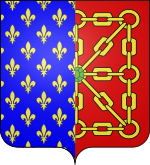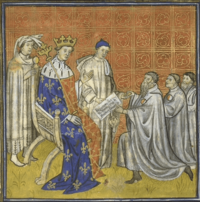Louis X of France facts for kids
Quick facts for kids Louis X |
|
|---|---|
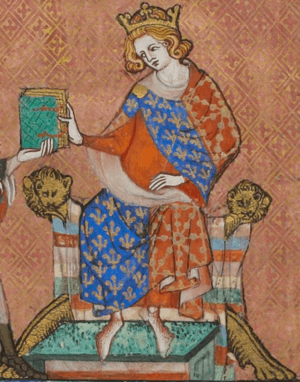
Miniature depiction from the Vie de saint Louis, c. 1330–1340
|
|
| King of France (more...) | |
| Reign | 29 November 1314 – 5 June 1316 |
| Coronation | 24 August 1315, Reims |
| Predecessor | Philip IV |
| Successor | John I |
| King of Navarre | |
| Reign | 4 April 1305 – 5 June 1316 |
| Coronation | 1 October 1307, Pamplona |
| Predecessor | Joan I and Philip I |
| Successor | John I |
| Born | 4 October 1289 Paris, France |
| Died | 5 June 1316 (aged 26) Vincennes, Val-de-Marne, France |
| Burial | 7 June 1316 Saint Denis Basilica |
| Spouse | Margaret of Burgundy (m. 1305, d. 1315) Clementia of Hungary (m. 1315) |
| Issue | |
| House | Capet |
| Father | Philip IV of France |
| Mother | Joan I of Navarre |
Louis X (born October 4, 1289 – died June 5, 1316) was a king of France and Navarre. He was known as the Quarrelsome (le Hutin in French). He became King of Navarre in 1305 and King of France in 1314.
During his short time as king, Louis X made some big changes. He allowed serfs (people tied to the land) to buy their freedom. He also let Jewish people return to France after they had been forced to leave. However, his rule in France was also a bit difficult. There were disagreements with the nobles, partly because of new taxes and government changes started by his father, King Philip IV.
Louis married Clémence of Hungary in 1315. Sadly, he died on June 5, 1316, leaving his wife pregnant. Clémence later gave birth to a boy, who was named King John I. But baby John lived for only five days. After John's death, Louis's brother, Philip, became the next king, Philip V.
Contents
Early Life and First Marriage
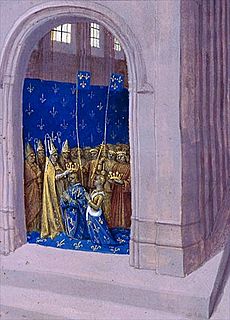
Louis was born in Paris. He was the oldest son of King Philip IV of France and Joan I of Navarre. When his mother died on April 4, 1305, Louis became the King of Navarre. He was crowned there on October 1, 1307.
On September 21, 1305, when he was 15, Louis married Margaret of Burgundy. They had one daughter named Joan. Louis was called "the Quarrelsome" because of the many disagreements and tensions during his time as king.
Near the end of his father's reign, Louis and Margaret were involved in a scandal known as the Tour de Nesle affair. Margaret was found guilty of wrongdoing and was sent to prison at Chateau Gaillard in Normandy.
When his father died in 1314, Louis became King of France. Even though Margaret was in prison, she was technically the Queen of France. Louis wanted to end his marriage to Margaret, but he couldn't because there was no pope at the time to approve it. Margaret died in prison on August 14, 1315. Just five days later, on August 19, Louis married Clémence of Hungary. She was the daughter of Charles Martel of Anjou. Louis and Clémence were crowned together in Reims in August 1315.
Family Life
In 1305, Louis married Margaret of Burgundy. They had one daughter:
In 1315, Louis married Clémence of Hungary. She gave birth to a son, John I of France, five months after Louis's death. Sadly, baby John died just a few days later. This led to arguments over who should be the next king.
Changes During His Reign
Louis was King of Navarre for eleven years. He was King of France for less than two years. His time as king was marked by constant disagreements with powerful noble families. He also made big changes to increase the royal treasury. These changes included freeing serfs and allowing Jewish people to return to France.
Nobles and Royal Power
Towards the end of King Philip IV's reign, many nobles were unhappy with his new taxes. When Louis became king, these disagreements grew into open revolts. Some people think Louis's young age might have encouraged these rebellions. Groups of nobles formed across the country, demanding changes.
Charles of Valois, Louis's uncle, used this situation to go against Enguerrand de Marigny. De Marigny had been a powerful minister under Philip IV. Charles convinced Louis to accuse de Marigny of various crimes. De Marigny was eventually executed in April 1315. After this, Louis stopped many of his father's reforms. He also issued many charters (documents granting rights) to the nobles. This helped calm down the regional groups.
Freeing the Serfs
In July 1315, Louis X issued an important order. This order basically ended serfdom in the lands directly controlled by the king. Serfs were people who were tied to the land and had to work for a lord.
Louis needed money for a war against Flanders. He saw freeing the serfs as a way to get it. He declared that French serfs could become free, but each serf had to buy their freedom. A group of officials was set up to figure out how much each serf's freedom would cost. If the serfs belonged directly to the king, all the money went to the Crown. If they belonged to other nobles, the money was split between the Crown and the noble.
Jewish People Return
Louis also changed the policy towards Jewish people. In 1306, his father, Philip IV, had forced all Jewish people to leave France. This was a very difficult time for these communities. Louis started to think about letting them return. He was partly motivated by the extra money the Crown could gain.
So, in 1315, Louis issued a special document. This document allowed Jewish people to come back to France under certain rules. They could only stay for twelve years, and the agreement could be ended after that. Jewish people had to wear a special armband at all times. They could only live in areas where Jewish communities had been before. At first, they were not allowed to lend money with interest. This was the first time French Jews were covered by such a document. Louis explained his decision by saying that his ancestor, Saint Louis IX, and even Pope Clement V supported it. He also claimed the people of France wanted the Jews to return. As a result, the Jewish community that returned was much weaker. They depended directly on the king for their right to live and be protected in France.
Conflict with Flanders
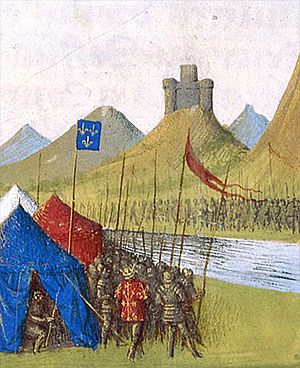
Louis X continued the efforts of his father to solve the problem with Flanders. Flanders was a very rich area that acted almost like an independent country, even though French kings claimed to rule over it. His father, Philip IV, had tried to take control, but his army was defeated in 1302. Even after a later French victory, the relationship remained difficult.
Louis gathered an army near the border of Flanders. But keeping an army ready for war was very expensive. Louis had stopped all exports of grain and other goods to Flanders in 1315. This was hard to enforce. The king had to pressure church officials and even Edward II of England to help stop Spanish merchant ships from trading with Flanders. One unexpected result of this ban was an increase in smuggling. This made it harder for the king to control trade. Louis also had to take food directly from local lords and the Church for his soldiers. This led to many complaints.
Death and Legacy
Louis was a big fan of jeu de paume, an early form of real tennis. He is famous for being the first person to build indoor tennis courts in the modern style. Louis didn't like playing tennis outdoors. So, he had indoor, enclosed courts built in Paris around the end of the 13th century. This design later spread to royal palaces across Europe.
On June 5, 1316, in Vincennes, after a very tiring game of tennis, Louis drank a lot of cold wine. He then died from what was likely pneumonia or pleurisy. However, some people suspected he might have been poisoned. Because of how he died, Louis is known as the first tennis player in history whose name we know. He and his second wife, Clémence, are buried in Saint Denis Basilica.
When Louis died, his second wife, Clémence, was pregnant. This made the question of who would be the next king very uncertain. If it was a boy, he would become king. But if it was a girl, her claim to the throne would be weaker. She would also have to compete with Louis's daughter, Joan, from his first marriage. Because of this, Louis's brother, Philip, was chosen to rule as regent for five months until the child was born. The child was a boy, John I, but he lived for only five days. After John's death, Philip successfully claimed the crowns of France and Navarre for himself.
All the later kings and queens of Navarre from 1328 onwards were descendants of Louis through his daughter, Joan. This includes Jeanne d'Albret, who was the mother of Henry IV of France. This means the entire royal House of Bourbon family is descended from Louis X.
In Fiction
Louis is an important character in Les Rois maudits (The Accursed Kings). This is a series of French historical novels by Maurice Druon. He was played by Georges Ser in the 1972 French TV series and by Guillaume Depardieu in the 2005 TV series.
Ancestors
| Ancestors of Louis X of France | |||||||||||||||||||||||||||||||||||||||||||||||||||||||||||||||||||||||||||||||||||||||||||||||||||||||||||||||||||||||||||||||||||||||||||||||||||||||||||||||||||||||||||||||||||||||||||||||||||||||||||||||||||||||||||||||||||||||||||||||||||||||||||||||||||||||||||||||||||||||||
|---|---|---|---|---|---|---|---|---|---|---|---|---|---|---|---|---|---|---|---|---|---|---|---|---|---|---|---|---|---|---|---|---|---|---|---|---|---|---|---|---|---|---|---|---|---|---|---|---|---|---|---|---|---|---|---|---|---|---|---|---|---|---|---|---|---|---|---|---|---|---|---|---|---|---|---|---|---|---|---|---|---|---|---|---|---|---|---|---|---|---|---|---|---|---|---|---|---|---|---|---|---|---|---|---|---|---|---|---|---|---|---|---|---|---|---|---|---|---|---|---|---|---|---|---|---|---|---|---|---|---|---|---|---|---|---|---|---|---|---|---|---|---|---|---|---|---|---|---|---|---|---|---|---|---|---|---|---|---|---|---|---|---|---|---|---|---|---|---|---|---|---|---|---|---|---|---|---|---|---|---|---|---|---|---|---|---|---|---|---|---|---|---|---|---|---|---|---|---|---|---|---|---|---|---|---|---|---|---|---|---|---|---|---|---|---|---|---|---|---|---|---|---|---|---|---|---|---|---|---|---|---|---|---|---|---|---|---|---|---|---|---|---|---|---|---|---|---|---|---|---|---|---|---|---|---|---|---|---|---|---|---|---|---|---|---|---|---|---|---|---|---|---|---|---|---|---|---|---|---|---|---|
|
|||||||||||||||||||||||||||||||||||||||||||||||||||||||||||||||||||||||||||||||||||||||||||||||||||||||||||||||||||||||||||||||||||||||||||||||||||||||||||||||||||||||||||||||||||||||||||||||||||||||||||||||||||||||||||||||||||||||||||||||||||||||||||||||||||||||||||||||||||||||||
Images for kids
See also
 In Spanish: Luis X de Francia para niños
In Spanish: Luis X de Francia para niños


